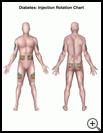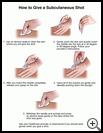
Diabetic Ketoacidosis Discharge Information
What is diabetic ketoacidosis?
Having diabetes means that there is too much sugar (glucose) in your blood. When you eat food, your body breaks down much of the food into glucose. Your blood carries the glucose to the cells of your body. An organ in your upper belly called the pancreas makes and releases a hormone called insulin when it detects glucose. Your body uses insulin to help move the glucose from the bloodstream into the cells for energy. When your body does not make insulin (type 1 diabetes), or has trouble using insulin (type 2 diabetes), glucose cannot get into your cells. The glucose level in your blood goes up. Too much glucose in your blood (also called hyperglycemia or high blood sugar) can cause many problems.
People with type 1 diabetes are at risk for a problem called diabetic ketoacidosis (DKA). It is very rare in people with type 2 diabetes. DKA happens when your body does not have enough insulin to move glucose into your cells, and your body begins to burn fat for energy. The burning of fats makes a byproduct called ketones. With DKA, the ketones can build-up to dangerous levels and cause an imbalance of chemicals (acids and bases) in your blood. At the same time, glucose also builds up in the blood. DKA is an emergency that must be treated right away. If it is not treated right away, it can cause coma or death.
How can I take care of myself when I go home?
How long it takes to get better depends on how well you respond to treatment, your overall health, and any complications you may have. The complications of diabetes, including DKA, can be delayed or even prevented by taking care of yourself and maintaining good blood glucose control.
Management
- Know when and how to test your blood glucose. Keep a log of your blood glucose measurements.
- Ask your healthcare provider about the symptoms and causes of low blood glucose and what to do when you have low blood glucose. Carry some form of sugar at all times, so you can treat low blood glucose quickly.
- Your provider will give you a list of your medicines when you leave the hospital.
- Know your medicines. Know what they look like, how much you should take each time, how often you should take them, and why you take each one.
- Take your medicines exactly as your provide recommends.
- Carry a list of your medicines in your wallet or purse. Include any nonprescription medicines and supplements on the list.
- Talk to your provider before you use any other medicines, including nonprescription medicines.
- Your provider may prescribe medicines to:
- Control your blood glucose
- Treat other medical problems that may have been caused by or made worse by diabetes
- Treat pain
- Treat or prevent an infection
- Treat or prevent side effects, such as nausea or constipation, from other treatments
- Replace vitamins and minerals
- Your provider may recommend other types of therapy to help relieve pain, other symptoms, or side effects of treatment.
Appointments
- Follow your provider's recommendations for follow-up visits and routine tests.
- Talk to your provider about the following tests and how often you need to have them:
- Regular hemoglobin A1C testing to check your average blood glucose control over the past 3 months. This is the best way to see if you are keeping your diabetes under control. Hemoglobin A1C is also known as HbA1C and A1C.
- Regular blood pressure and cholesterol screenings. Maintaining good control of your blood pressure and cholesterol may help prevent heart attacks and strokes.
- An eye exam by an eye doctor. Your eye care provider may use eye drops to dilate your pupils. The eye drops open up the pupils so that the provider can see the back of your eye. Women with diabetes who become pregnant should have their eyes checked each trimester because diabetic eye problems can worsen quickly during pregnancy.
- A foot exam by a healthcare provider to check for foot problems.
- Urine and blood tests to check how well your kidneys are working.
Talk with your provider about any questions or concerns you have.
Diet, Physical Activity, and Other Lifestyle Changes
- Follow the treatment plan your healthcare provider prescribes.
- Learn about diabetes and its complications so you can make the correct decisions to control your blood glucose levels. Talk to your healthcare provider about how you can learn all you need to know. You can also check with the local American Diabetes Association chapter, hospital, or health department about classes in your area or diabetes educators who can help you.
- You may need to make changes in some of the foods you eat. Ask your provider about the benefits of talking to a dietician to learn what you need in a healthy diet.
- Ask your healthcare provider if there are foods or medicines you should avoid.
- Drink enough fluids to keep your urine light yellow in color, unless you are told to limit fluids.
- Limit the amount of alcohol you drink. It can cause low blood glucose as well as worsen nervous system problems caused by diabetes.
- Lose weight if you need to and keep a healthy weight.
- Do physical activity as your provider recommends.
- When you increase your activity, check your blood glucose more often. If you take insulin, you may need to eat more or decrease the amount you are taking, according to your healthcare providers instructions. This will help prevent low blood glucose.
- Follow activity restrictions, such as not driving or operating machinery, as recommended by your healthcare provider or pharmacist, especially if you are taking pain medicines.
- Do not smoke. Smoking can cause poor blood circulation and reduce healing.
- Be prepared for illness by knowing what to do when you get sick. Diabetes is harder to control when you are sick. Blood glucose can get very high during an illness and become a medical emergency. Your healthcare provider will work with you to develop a sick-day plan just for you.
- It is important to try to prevent infection. People who have diabetes are at risk for infection. If you are diabetic and have an infection, your blood glucose often rises above your usual levels.
- Learn how to do proper skin and foot care every day.
- Check your feet and lower legs for red skin areas and open sores.
- Wear comfortable, well-fitting shoes to help prevent foot injury.
- Break in new shoes gradually.
- Ask your provider about how to trim your toenails properly.
- Carry an ID card or medical alert jewelry that says you have diabetes, in case of an emergency.
- It's also good for your family to learn about diabetes. Make sure your family members know what to do if your blood glucose is too high or too low.
- Find ways to make your life less stressful.
- Having diabetes or complications of diabetes can be scary or depressing. You may wish to talk with a therapist about your feelings.
Call your provider right away if you have new or worsening:
- Very low or very high blood glucose that you cannot control with your usual treatments
- Increased urination or trouble emptying your bladder
- Increased thirst and dry mouth
- Shortness of breath
- Nausea or vomiting
- Abdominal pain
- Confusion
- Weakness
- Tiredness
- Fruity odor to breath
Last modified: 2016-02-18
Last reviewed: 2016-02-12



